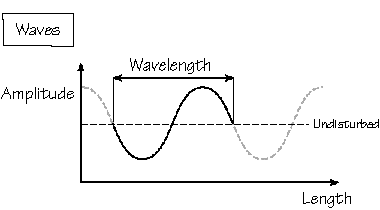Chapter 2, Earth: Origin and Composition - 03
Information and Light
We can estimate the composition of interstellar clouds, galaxies, stars, and planets by studying the light they emit, absorb, or reflect. Light is a wave, and different colors of light have different wavelengths

Light is one of many familiar electromagnetic waves:
|
|
|
|
|
|
|
|
|
|
|
|
|
|
|
|
|
|
|
|
|
|
|
|
Sources of light emit light at characteristic frequencies. We can use an instrument such as a prism to separate light into it's native frequency constituents.

Electrons inhabit energy states that we call "shells". The observed spectral patterns arise from the "movement" of electrons between quantized electron energy "states". In a burning star, electrons are constantly absorbing and emitting energy and mak ing transitions from one energy shell to another.
A result of the jump that decreases and electron's energy state is the emission of a photon (a "particle" of light) with a specific frequency. Different elements have different electron configurations, thus the transition of electron energy releases photons of characteristic frequency, producing in effect a spec tral fingerprint of the element.
If we observe and split the light emanating from stars, galaxies, etc., we find a line spectrum, because only certain frequencies are permitted (a consequence explained by a fascinating scientific theory called Quantum Mechanics).
Because the process works backwards as well (an electron can absorb a photon with a specific frequency and go to a higher energy state) we can observe two types of spectra: absorption and emission.
We are now in a position to examine an important observation in support of the Big Bang Hypothesis - red shifts in the spectra of galaxies.